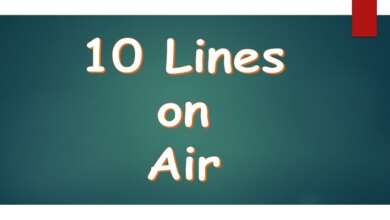10 Lines on Indian Railway in English for Students and Children
10 Lines on Indian Railway
10 Lines on Indian Railway – Lord Dalhousie is called the father of Indian Railways, it is only with this invention that the transportation of passengers and goods from one place to another has become possible. It conducts a range of activities such as sightseeing, trade, and pilgrimage, along with freight transport.
Now it is a statutory body owned by the government’s Ministry of Railways that regulates the Indian railway system and manages the world’s fourth largest national railway system.
Set (1) 10 Lines on Indian Railway
1. Indian Railways first came into existence in 1853 on 16th April.
2. The Indian first passenger train from Bori Bunder in Mumbai to Thane covering a distance of 34 km with 30 wagons.
3. This train was first run by three locomotives named Sahib, Sultan, and Sindh.
4. Indian Railways is the fourth largest railway network in the world, followed by the US, China, and Russia.
5. Indian Railways has an electrified rail network of more than 45,000 km.
6. Indian Railways has 5 royal trains namely Royal Rajasthan on Wheels, The Golden Chariot, Palace on Wheels, The Deccan Odyssey, and The Maharaja Express.
7. The longest route of Indian Railways is Vivek Express which is from Kanyakumari to Dibrugarh, covering a distance of 4189 km. covers.
8. The shortest train ride in India can be taken from Nagpur to Ajni which covers a distance of just 3 km.
9. Indian Railways are the most important rail routes globally, operated by a single government.
10. The Rail Museum of Delhi is the first railway museum in India, also known as the National Rail Museum.
***********************************************
Set (2) 10 Lines on Indian Railway
1. Indian Railways is the largest government organization in India.
2. The first train in India was run between Mumbai and Thane, which is now a lifeline for the people of India.
3. First of all, the British started the rail system to exploit India’s resources and to carry raw materials from various ports of India.
4. In the development of railways after independence, the Government of India established its own separate Ministry of Railways.
5. It is operated by the central government, in which the state government has no right to interfere in the railway network.
6. Indian Railways is working regularly to provide good facilities to its passengers.
7. Railway is a general class for economically weaker section people, there is a second class above it provides first class service above them.
8. For the security of the Railways, the Government of India has created a separate paramilitary force RPF. Its main function is to protect railway property and passengers.
9. During national calamity or any accident, railways play an important role by providing food, medicine, doctors, and other help in a very short time.
10. Indian Railways runs many luxury trains in collaboration with the Ministry of Tourism.
Read also –
***********************************************
Q&A. 10 Lines on Indian Railway
What is Railway in India?
Answer – Indian Railways is a statutory body owned by the Ministry of Railways, Government of India that regulates the Indian railway system. It manages the world’s fourth largest national railway system.
Who is the father of railways in India?
Answer – Lord Dalhousie is called the father of Indian Railways, as it introduced the rail system to harness the resources and carry raw materials from various ports of India.
What is the importance of Indian Railways?
Answer – Railway is the main means of transport of passengers and goods in India. It conducts a range of activities such as sightseeing, trade, and pilgrimage, along with freight transport.




